Don’t Be Blue: A Team Effort to Protect the Heritage of Maine’s Wild Blueberries
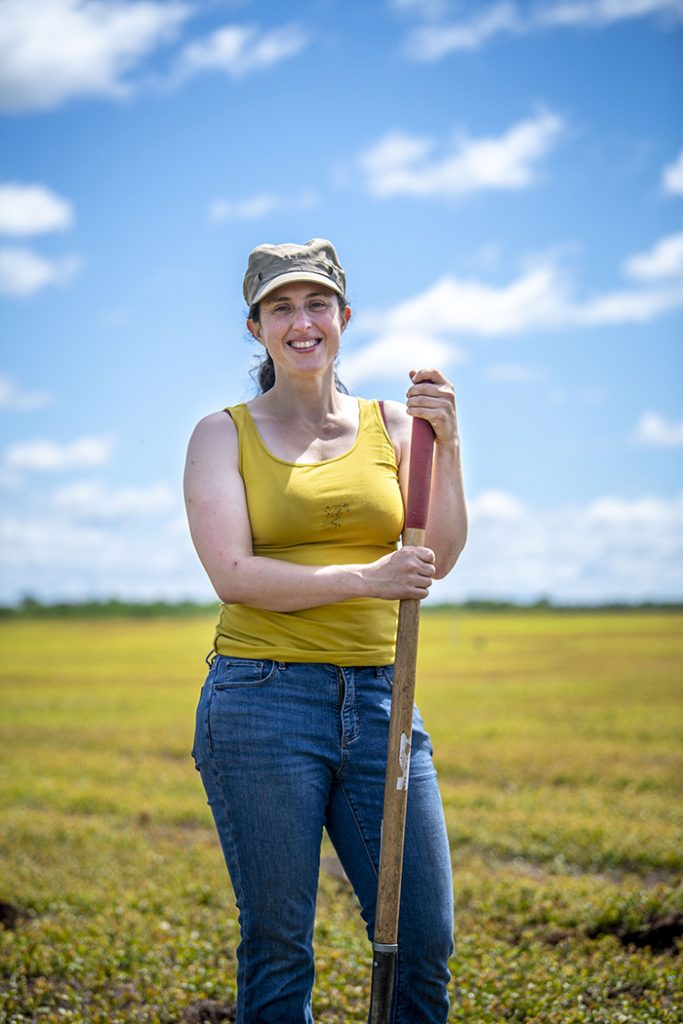
Story by Sonja Heyck-Merlin
What do the tidy rows of plastic covered tunnels at Wyman’s Wild Blueberry Research and Innovation Center have to do with the future enjoyment of a juicy, wild blueberry pie?
The tunnels are part of a four-year agricultural trial designed to understand how wild blueberries, Maine’s state fruit, will respond to different climate scenarios. The project is funded by a $650,000 grant from the USDA National Institute of Food and Agriculture.
The research center was created in 2022 through a gift from Wyman’s, a wild blueberry grower (managing 18,000 acres of berries) and processor based in Milbridge, Maine. It’s the first time there has been a designated wild blueberry research site on the UMaine campus in Orono/Old Town.
The trial is led by Rachel Schattman, an associate professor of sustainable agriculture, a Mitchell Center faculty fellow, and the leader of the UMaine Agroecology Lab. Agroecology is often referred to as a “science, movement, and a practice” that considers agriculture within the context of ecological and social systems. The trial is a interdisciplinary collaboration including the wild blueberry industry, plant physiologists, entomologists, mycologists, climatologists, economists, and crop modelers.
“As an agroecologist, I have always envisioned collaborating with an interdisciplinary team of researchers, as I believe it’s a collective responsibility to work together in finding solutions to our farmers’ problems,” said Ali Bello, a doctoral student working with Schattman.
Coaxing Wild Plants Into Production
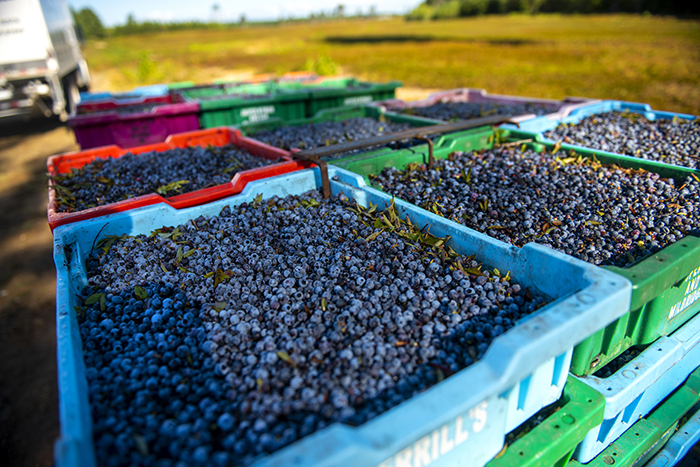
Wild blueberries (Vaccinium angustifolium) are iconic to Maine’s landscape and part of a 25,000 year geologic history. The opportunistic and tenacious plants began to spread slowly across the Northeast about 10,000 years ago as the mile thick glacier covering the region, which had been retreating and carving the landscape for nearly 15,000 years, finally melted. Created by this glacial activity, the blueberry barrens, as they are called, are hills of well-drained, sandy, and acidic soil, primarily located in eastern Maine and maritime Canada.
Although they’re called wild blueberries, being one of the only native fruits to North America, the crop is managed to increase yield, reduce competition and pests, and make harvesting easier.
Wild blueberries are agriculturally important to Maine. According to Eric Venturini, the executive director of the Wild Blueberry Commission of Maine (WBCM), in 2023, the state produced 74 million pounds representing nearly 100% of all wild blueberries grown in the United States. Annually, the industry contributes an estimated $361 million dollars in sales to Maine’s economy.
The crop is also culturally significant. During harvest season, the laden plants hang heavy with many shades of blue berries. In the fall, the colors of the small crimson leaves are as enchanting as those of a sugar maple stand. The wild blueberry has long been an important part of Wabanaki food systems and culture.
Wild Blueberry Growers Seeking Solutions
Prior research, however, shows that the crop is susceptible to climate change. Climate projections for Maine and maritime Canada suggest that by the end of the century the fruit will only receive enough rainfall in August (when blueberries are ripening) in one out of every five years. Predicted warming is also expected to affect the crop.
Wild blueberry growers across Maine are concerned about the impact of climate change on their livelihoods. So much so that the goals of the WBCM, which serve as a collective voice for the industry, include supporting and fostering research, innovation, economic tools, and opportunities that aid climate change adaptation.
Lisa Hanscom is a sixth generation wild blueberry grower in Roque Bluffs, Maine and a member of a WBCM grower committee. She hopes Schattman’s research might help her family farm adapt to changes she’s observed — long, dry spells, heavy rainfall events, an earlier harvest season, and changing pest and weed pressures.
“These conditions change what you need to know as a farmer. They change the insects, blueberry plants, and invasive plants. They change when you’re going to get workers and when your crop season starts. It’s not just about going out and tending to the field anymore,” Hanscom said.
Setting up the Research Site
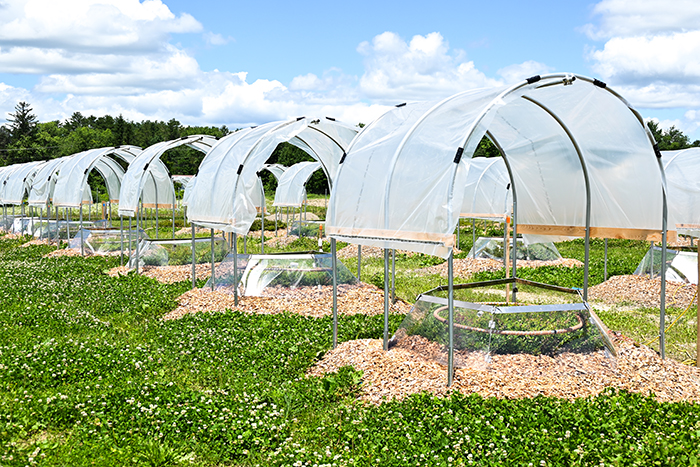
In the fall of 2023, in collaboration with Wyman’s, Schattman and her team relocated clumps of wild blueberry plants to berms at the Wyman’s Research Center to mimic the growing conditions of the barrens.
With a mini backhoe, they dug several pits, lined them with plastic barriers to reduce lateral water movement through the soil, and filled the pits with gravel. Once planted, the plots were covered with plastic hoop structures to keep out the majority of precipitation. Then, they covered the berms with wood chips that will eventually decompose as the plants start to spread out and the blueberries grow into a mat.
After transplanting, the plants were measured for several important variables including plant size, number of flower buds, average chlorophyll content, leaf and stem biomass, nutrients, etc.
The plots are uncovered during the non-growing season to allow for natural temperatures and precipitation, and the plants are sprayed for disease control and harvested as they would be in the barrens.
Understanding the Role of Precipitation and Temperature
One of the project’s goals is to understand how different temperatures and rainfall patterns impact soil, water, crop health, root fungi, pollinators, and disease.
To accomplish this, Sean Birkel, the Maine state climatologist designed three precipitation treatments. They mimic an extremely wet year, a dry year, and a very wet spring with a dry fall. These conditions replicate several scenarios that climate models predict are apt to become more common.
The temperature treatments use open-top plexiglass chambers over the tops of some plants to slightly increase the temperature. Other plots use heating coils inside the chambers to increase the temperatures even more. Then, there’s an unheated control group.
Weather stations installed in the center of each chamber or control record temperature, relative humidity, soil temperature, and soil water content.
Understanding Ecosystem Dynamics
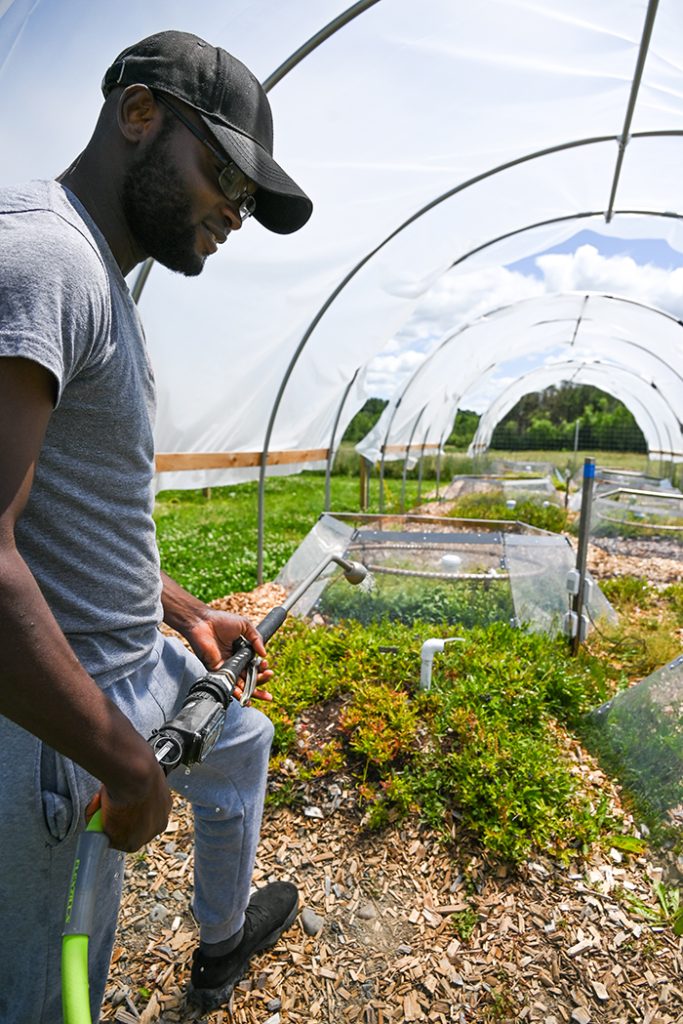
Unlike a field of corn, which contains one variety, wild blueberries have never been bred, so the varieties are unknown even though the plants all belong to the Vaccinium angustifolium species. Wild blueberries are unique because a field can contain thousands of genetic individuals — called genotypes — that spread via the plants’ rhizomes. The blueberry barrens are a patchwork of thousands of genotypes, visible to the eye by their variations in height, color, when they flower, and when they ripen.
Another of Schattman’s goals is to study how individual genotypes fare under these different temperature and precipitation conditions. Some of the berms are called isolation plots because the genotypes are planted on their own. Berms that contain a diversity of genotypes are called community plots.
Schattman is curious to see how the isolation and community plots respond to the changes in conditions. According to her, no one has ever studied whether or not there is some interaction going on between these individual genotypes that might facilitate some of their resilience to climate change.
“Comparing these two approaches will help us understand the role of genetic diversity in sustaining ecosystem services within wild blueberry agroecosystems,” said Bello.
When the data is eventually analyzed, Schattman and her team hope to be able to estimate how well wild blueberries will fare in future conditions. Dr. Stephanie Miller, a crop modeler on the team, is developing a crop yield and performance calculator based on models used for crops like corn and soybeans.
Bringing Water Research to the Forefront
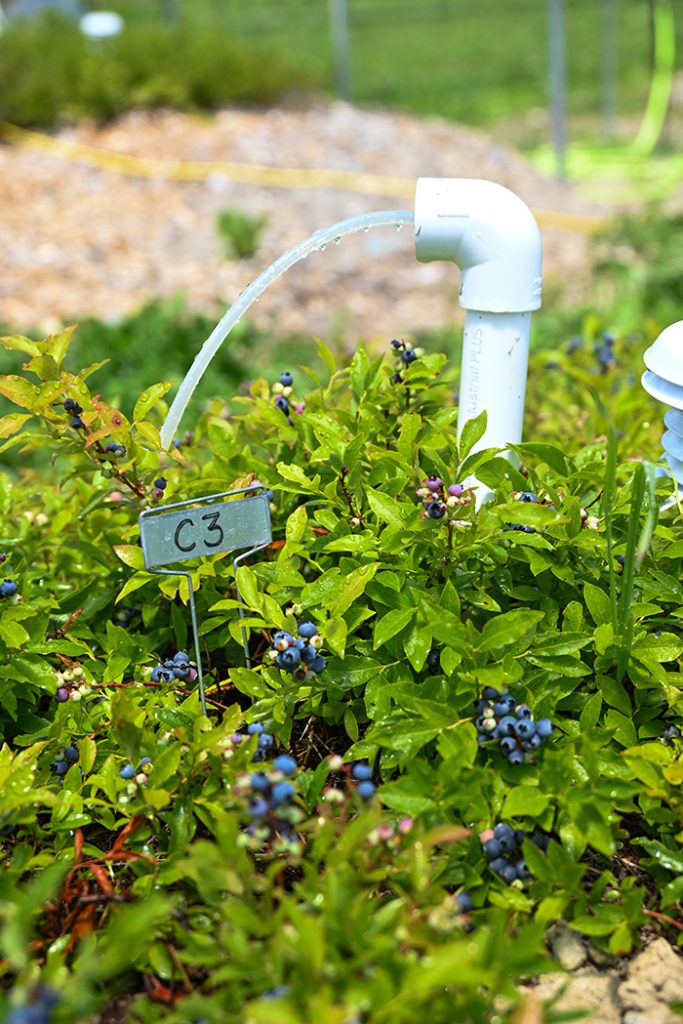
The team is also researching the economic implications of installing water management systems on blueberry farms.
“I anticipate showing that there are going to be some parts of the state where we currently have very productive blueberry operations that will be more challenged because of changing temperatures and changing rainfall,” said Schattman.
Water is constantly on Schattman’s mind as she listens to growers across the state who are concerned about the impacts of climate change on their crops. These conversations motivate much of her and her colleagues current research, some of which has been funded by the Mitchell Center and the U.S. Geological Survey’s 104(b) program. This includes the development of novel shallow wells as one strategy for affordably getting water to Maine’s crops and examining how biochar can play a role in water conservation.
Irrigation, according to Schattman, will continue to be part of the industry’s adaptation to climate change. Wild blueberry growers, however, are under-resourced when it comes to ponds, wells, pipes, and sprinkler heads. Schattman foresees that this research might help with directing growers’ irrigation investments more efficiently or helping the industry advocate for more support from state and federal agriculture programs.
Hanscom at Welch Farm would love to have some financial support for irrigation. “I don’t have the infrastructure right now to actually irrigate. I have a pond, and the plan is hopefully that someday I’m going to be able to have irrigation, even if it’s just on what I grow for fresh berries,” Hanscom said.
After all, the Welch farm has been growing wild blueberries for 100 years, and Hanscom hopes that her grandson who loves everything to do with farming can carry on the tradition if he wants.. “Anything that has to do with the farm, he’s all in,” Hanscom said.
Schattman’s team, in the meantime, continues to diligently monitor the blueberry berms. She hopes that the team’s research will help the industry become more resilient to climate change, so Hanscom’s grandson can carry on the family tradition and ensure that slices of flavorful, wild blueberry pie retain their prominent place on Maine’s tables.
